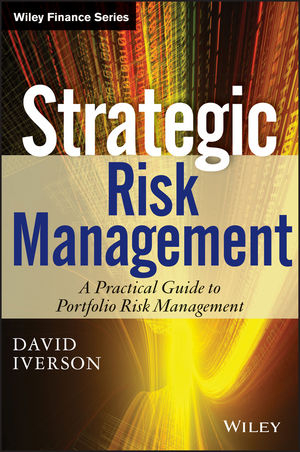
Strategic Risk Management
John Wiley & Sons Inc (Verlag)
978-1-118-17640-5 (ISBN)
- Titel ist leider vergriffen;
keine Neuauflage - Artikel merken
Since all investors seek maximize returns balanced against acceptable risks, successful investment management is all about successful risk management. Strategic Risk Management uses that reality as a starting point, showing investors how to make risk management a process rather than just another tool in the investor′s kit. The book highlights and explains primary investment risks and shows readers how to manage them across the key areas of any fund, including investment objectives, asset allocation, asset class strategy, and manager selection. With a strong focus on risk management at the time of asset allocation and at the time of implementation, the book offers important guidance for managers of benefit plans, endowments, defined contribution schemes, and family trusts.
Offers a thorough examination of the role of risk management in the decision–making process for asset allocation, manager selection, and other duties of fund managersWritten by the current head of portfolio design for the New Zealand Superannuation FundAddresses the fundamental importance of risk management in today′s post–crisis fund management landscape
Strategic Risk Management is a comprehensive and easy–to–read guide that identifies the primary risks investors face and reveals how best to manage them.
DAVID IVERSON is Head of Asset Allocation with New Zealand Superannuation Fund. He was previously Director of Institutional Investment Services & Quantitative Research at Goldman Sachs JBWere and has also held positions with Russell Investment Group, ING Investment Management, and ABN AMRO.
Acknowledgments xi
Preface xiii
Chapter 1 Strategic Risk Management Framework 1
Organizing Framework 1
What Risks Does the Fund Face at Each Level? 4
Summary 11
Putting the Ideas into Action 12
Chapter 2 Governance Risk 17
Why Governance Matters 17
Good Governance 17
Signs of Poor Governance 26
Chapter 3 Investment Beliefs 31
Why Have Investment Beliefs? 31
Knowledge and Investment Beliefs 33
Investment Beliefs and Strategy 33
Categories of Investment Beliefs 34
Examples of Investment Beliefs 35
Approach to Developing Investment Beliefs 35
Putting the Ideas into Action 42
Chapter 4 Fund s Purpose 45
Clear Definition 45
Possible Ways to Express Objectives 46
Examples 47
Chapter 5 Strategic Asset Allocation 49
Guiding Principles 49
Key Steps 50
Capital Market Assumptions 51
Candidate Portfolios 58
Chapter 6 Hedge Funds 87
Not an Asset Class 87
Types of Strategies 88
Characteristics of Hedge Funds 89
Risks of Investing in Hedge Funds 91
Risk and Return Characteristics 96
Good Implementation 100
Reasonable Risk and Return Expectations 102
Chapter 7 Private Equity 103
Types of Private Equity 104
Stages of Investment 104
Features of Private Equity 105
Risks of Private Equity 106
Managing the Risks 107
Fund of Funds 110
Suitability for an Investor s Portfolio 111
Risk and Return Characteristics 111
Reasonable Risk and Return Expectations 112
Achieving Private Equity Allocations 113
Chapter 8 Benchmarks 115
What Are Benchmarks For? 115
Characteristics of Good Benchmarks 116
Market Capitalization and Benchmarks 119
Chapter 9 Tactical Asset Allocation 121
Tactical versus Strategic Asset Allocation 121
Approaches to TAA 122
TAA versus Global TAA versus DAA 122
Investment Beliefs 123
Conditions for Success 124
TAA Process 124
Evidence of Value Added 127
Market Timing and Time out of the Market 130
GTAA 133
Chapter 10 Active versus Passive Management 135
Decision Framework 135
Evidence on Market Efficiency 142
What Barriers Exist to Acceptance of the Concept of Market Efficiency? 149
Chapter 11 Passive Management 153
Physical Alternatives 153
Synthetic Implementation 154
Risk Considerations 154
Operational Considerations 155
Managing Risk with Derivatives An Example of Alpha Beta Separation 155
Chapter 12 Active Global Equities Structure 161
Active Risk and Return 161
Style Risks 163
Management Structure 169
Market Extensions 184
Chapter 13 Active Global Fixed Income Structure 187
Style 187
Management Structure 188
Market Extensions 190
Chapter 14 Manager Selection 193
Hiring Managers 193
Firing Managers 202
Fees 211
Performance–/Incentive–Based Investment Management Fees 212
Chapter 15 Execution 217
Rebalancing 217
Transitioning Managers 221
Chapter 16 Review and Monitoring 225
Levels of Performance Reporting 225
Sample Reports 226
Conclusion 235
Chapter 17 Case Study 1 Defined Benefit Plan 237
Background 237
Financial Position and Actuarial Valuation 237
Engaging an Investment Advisor 239
Investment Objectives 239
Asset Allocation Strategy 240
Chapter 18 Case Study 2 DC Member Investment Choice Fund 247
Plan Characteristics 247
Review of the Plan 249
Investment Objectives 249
Fund Design 250
Investment Strategy 253
Manager Structure 255
References 259
About the Author 273
Index 275
| Erscheint lt. Verlag | 18.11.2013 |
|---|---|
| Reihe/Serie | Wiley Finance Editions ; 1 |
| Verlagsort | New York |
| Sprache | englisch |
| Maße | 156 x 237 mm |
| Gewicht | 574 g |
| Themenwelt | Wirtschaft ► Betriebswirtschaft / Management ► Finanzierung |
| Betriebswirtschaft / Management ► Spezielle Betriebswirtschaftslehre ► Versicherungsbetriebslehre | |
| ISBN-10 | 1-118-17640-5 / 1118176405 |
| ISBN-13 | 978-1-118-17640-5 / 9781118176405 |
| Zustand | Neuware |
| Informationen gemäß Produktsicherheitsverordnung (GPSR) | |
| Haben Sie eine Frage zum Produkt? |
aus dem Bereich


